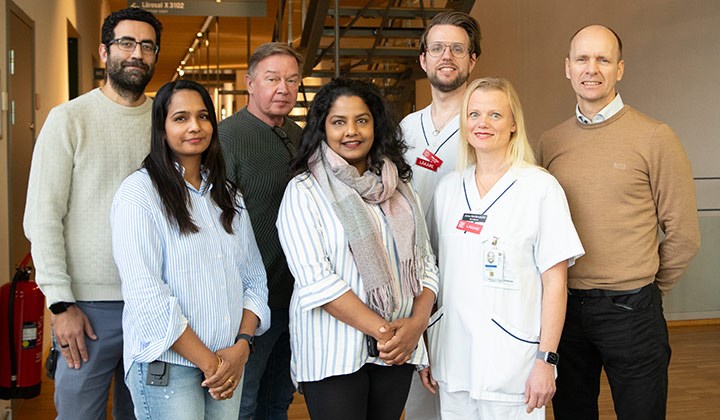New heart model using human cells aims to unravel the causes of heart diseases

Back row, from left: Isak Demirel, Allan Sirsjö, Niklas Steger, Simon Athlin. Front row, from left: Jishamol Thazhathveettil, Geena Paramel Varghese, Anna Nordenskjöld.
Researchers at Örebro University have created a heart model using human cells. The goal is to understand what causes cardiovascular diseases and why infections can increase the risk of developing them. “In the first study, we’ll examine blood from influenza patients who sought emergency care,” says researcher Geena Paramel.
Since this past summer, Geena Paramel, PhD in biomedicine, has been working on developing a miniature version of a human heart. With the help of Australian researchers, she has now successfully created a model consisting of human heart cells.
“What’s unique is that it contains three different types of cells, which will provide more advanced insight than previous models that included only one cell type. In addition to cardiac muscle cells, the model includes fibroblasts, which act as the heart’s supportive cells, and endothelial cells found in the heart’s blood vessels. The model may also help us understand disease mechanisms that cannot be observed in animal studies since mice and rats lack certain genes that humans have,” explains Geena Paramel.
The heart model represents human tissue that can mimic the heart’s functions. It is barely visible to the naked eye, but you can see how the model contracts under a microscope, just like a beating heart. Researchers have demonstrated that the model works, and the next project will use it to study various disease conditions.
“We know that certain infections increase the risk of conditions like stroke and heart attack, but not why. The next step is to add blood plasma from influenza patients to the model to see how it affects heart cells at the molecular level.”
Multiple areas of application
Blood samples have come from influenza patients who sought care at the emergency ward at Örebro University Hospital and Karlskoga Hospital. Anna Nordenskjöld sees many applications for the new heart model. She is docent at Örebro University and chief physician in cardiology at the Department of Heart-Lung Physiology at Örebro University Hospital.
“It consists of three cell types, all essential for the human heart to function and therefore of great interest to us. Under a microscope, we can see the cell structure beating, and we can precisely measure what happens to the cells’ function when they are exposed to various substances found in patients’ blood, medications, or toxins,” explains Anna Nordenskjöld.
Simon Athlin, docent at Örebro University and chief physician at the Department of Infectious Diseases at Örebro University Hospital, also sees tremendous potential in using the model for exploring vital research questions.
“It allows us to study how substances and biological molecules circulating in the blood affect the heart without needing to test them on individual patients. It’s also a model that research funders want to see more of as an alternative to animal testing,” says Simon Athlin.
New medication
In the long term, Simon Athlin envisions the model being used in developing new medication to protect the heart during infections like influenza by reducing the immune system’s impact on cardiac muscle cells.
“Although this is a goal for the future, our model provides the right conditions to study the effects of new drug candidates,” says Athlin.
Another advantage is that the heart model brings together researchers from different research fields.
“Since this project brings together basic researchers and clinicians from two different specialities, we learn from and inspire one another. As a clinically active cardiologist, I seldom meet basic researchers in my daily work,” says Anna Nordenskjöld.
Studying how heart cells interact
The heart model allows the study of how heart cells interact with one another has been funded by the Knowledge Foundation as part of the project Novel approaches to identify protein signatures and immune mechanisms underlying influenza induced cardiac pathogenesis in humans: focus on comprehensive proteomics and in vitro human heart microenvironment.
Research is conducted at the Cardiovascular Research Centre (CVRC), a translational research group at Örebro University and Örebro University Hospital/Region Örebro County.
Read more about the research project: In vitro human heart microenvironments: utilizing cardiac spheroids to study heart disease.
Text: Mikael Åberg
Photo: Linda Harradine
Translation: Jerry Gray
